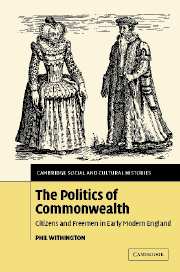Book contents
- Frontmatter
- Contents
- List of figures
- List of tables
- Acknowledgements
- Part I Introductions
- 1 Urbanisation and political culture in early modern England
- 2 The formation of the English corporate system
- Part II Cultural resources: ideology, place, company
- Part III Honest distinctions: economy, patriarchy, religion
- Conclusion
- Bibliography
- Index
2 - The formation of the English corporate system
Published online by Cambridge University Press: 23 December 2009
- Frontmatter
- Contents
- List of figures
- List of tables
- Acknowledgements
- Part I Introductions
- 1 Urbanisation and political culture in early modern England
- 2 The formation of the English corporate system
- Part II Cultural resources: ideology, place, company
- Part III Honest distinctions: economy, patriarchy, religion
- Conclusion
- Bibliography
- Index
Summary
‘No little glory to the land’
In 1611 the cartographer and historian John Speed published The theatre of the empire of Great Britain, explaining that his ‘principal motive of writing’ was the ‘zeal of my country's glory’, the ‘glory of our Nation being almost buried in the pit of obscurity’. The importance of urbanity to this humanist agenda was reflected simply in the layout of the text. In the English section of the book, the centrepiece of each chapter was a detailed map or ‘chart’ of a county across two folios on which were marked rivers (but not roads), townships and towns, and great castles and houses. Around the county map were placed smaller maps and illustrations. Inset against thirty-five counties was a bird's-eye map of the leading county town: Norwich accompanied Norfolk; Ipswich Suffolk; Dorchester Dorset; Shrewsbury Shropshire; and so on. For a further five counties, two towns were represented in this way: while Kent was depicted with Canterbury and Rochester, Berwick-upon-Tweed and Newcastle-upon-Tyne adorned Northumberland. The same model of isolating ‘great and good towns’ within their local contexts was repeated for Ireland and Wales, reflecting at once their role as centres of commerce within particular localities and their status as distinct, autonomous places in their own right.
The textual prominence of cities and boroughs reflected their cultural significance. In England they illustrated the wealth and commodity of the people: indeed, Speed's homeland was so commodious that there were ‘more beautiful and richer Corporations’ than could possibly be included.
- Type
- Chapter
- Information
- The Politics of CommonwealthCitizens and Freemen in Early Modern England, pp. 16 - 48Publisher: Cambridge University PressPrint publication year: 2005



